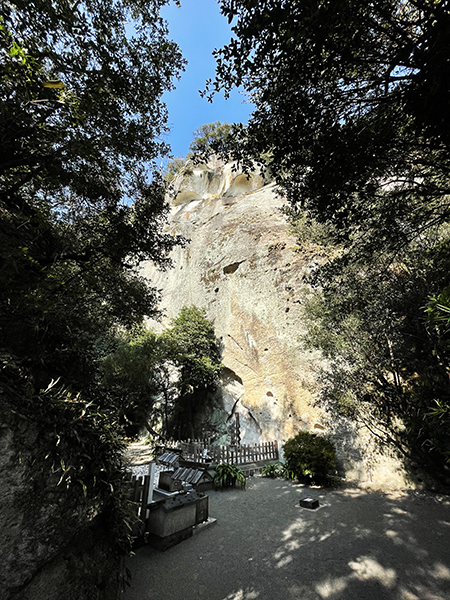
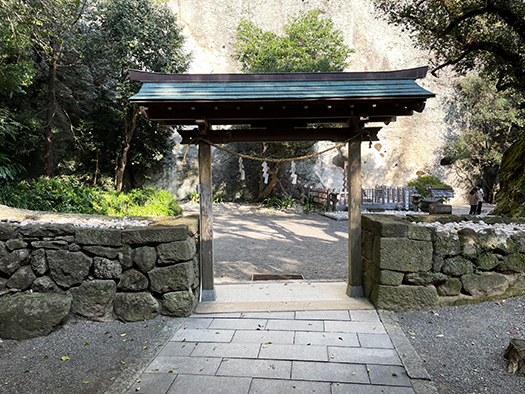
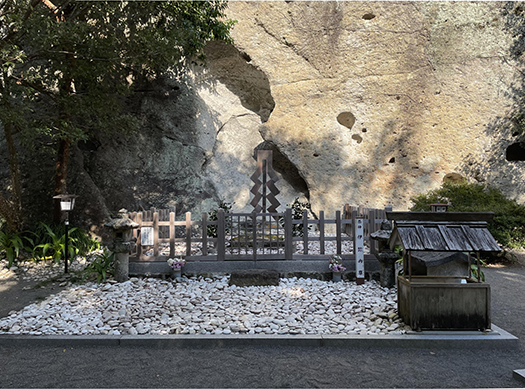
熊野に残る精神文化空間のひとつの象徴がこの花の窟神社。やはり一番奇異を感じるのは、本殿建築のかわりに巨石、露頭岩石をそのままイザナミのご神体としているポイントだろうか。
熊野本宮大社の古社があったとされる所在地・現大斎原は3つの河川の合流地点で、ひろやかな砕石・砂利石が清浄な、仏教的な言い方で言えば「三途の川原」を感じさせる空間の「神奈備」を訴求してくるけれど、しかしそこにたくさんの「高床式」の木造社殿が祀られていた。またアマテラスを祀る伊勢神宮も同様の木造の神殿群が展開している。
建築的に見れば「高床」とは集団的農耕の結果生産物であるコメの長期保存のために「通風性」を第一に考えた木造建築デザインだろう。湿潤な温熱環境のなかでしかもネズミなどの食害をも防ぐ意味からも床が高く上げられ、床下は風洞構造を目指している。内部の乾燥を第一に追求した性能とデザインの日本的完成形。
わたし的にはこういう「神奈備」についての花の窟神社と他社の社殿意識の相違は、やはり縄文から弥生への「精神伝統」の歴史的変化表現ではないかと思える。コメ文化が列島に流入してきたときの「在来」社会との関係性の表現かと。
日本列島でもコメ文化以前の「神奈備」空間として列石群などの空間は一般的にある。縄文由来の生活文化を継承してきた地域文化として、東北北部・北海道などで見ることができる。石器社会から連綿としてこのような巨石に「神宿る」と感じる精神性は底流としてあり続けたのだろうが、こんなふうな始原的な神奈備とその文化を初めて正視する思いがした。
そしてその象徴から「しめ縄」を海にまで長大に「つなげる」神事が継続し続けている奇観。いかにも「熊野」らしい習俗文化だと強くメッセージしてくる。
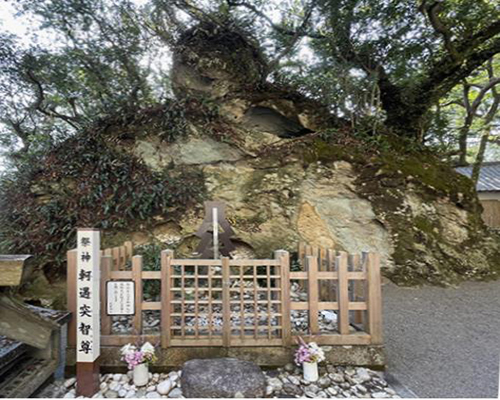
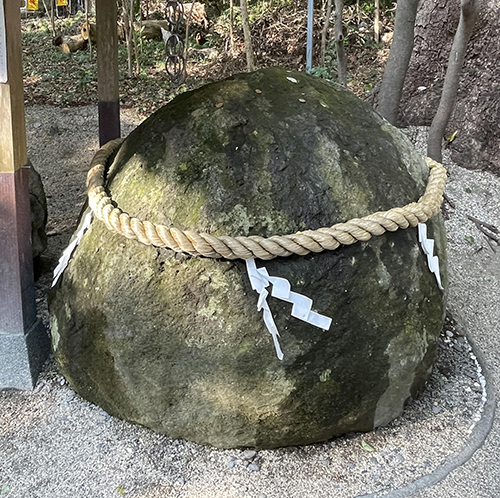
原初的な精神性神話の始原とされるイザナミ尊が身ごもって、火の神「カグツチノミコト」を産むとき火傷をして亡くなったので、ふたりを花の窟に葬ったのだという。花の窟神社には露頭岩の本殿に対置してカグツチの神体巨石がある。またさらに丸石が信仰対象として置かれている。イザナミの体内からこの丸石が飛び出してきたと言われる。
どうもこのあたりは、火山活動・造山活動の様子を「神宿る」ことがらとして信仰対象としてきた痕跡を感じさせられる。火山列島である国土で普遍的に「自然崇拝」が人びとのこころに根付き続けていたことを物語る。八百万の神々とは多様性に富んだ海洋性火山列島の国土にふさわしい精神文化なのでしょう。
そういう国土において皇統が統一的政体として、どのように維持し、発展していったのか。わたしの熊野詣、いよいよ核心的な部分・覚醒ポイントに差し掛かってきたと感じさせられています。
English version⬇
The Jomon-era “Gigantic Stone” Worship: The Myth of the Imperial Lineage and a Trip to Kumano-23
The Jomon-like worship of nature, the land where eight million gods dwell, and the imperial lineage as a symbol of rice culture. The missing link between these two cultures and harmony. …
The Hana-no-Kutsu Shrine is a symbol of one of Kumano’s remaining spiritual and cultural spaces. What is perhaps most unusual about the shrine is that instead of a main shrine building, a huge rock outcropping is used as the sacred body of Izanami.
The location where the old shrine of Kumano Hongu Taisha is said to have been located, the present Osaibara, is at the confluence of three rivers, and the open crushed stones and gravel stones are clean, appealing to the “Kannabis” of the space, which in Buddhist terms is the “Sanzu no Kawahara,” but there are many wooden shrine buildings built on stilts enshrined there. The Ise Jingu Shrine, dedicated to Amaterasu, also has a similar group of wooden temples.
From an architectural point of view, “stilts” are probably a wooden architectural design that places the highest priority on ventilation for the long-term preservation of rice, a product of collective agriculture. The floor is raised to prevent rodents and other predators from feeding on the rice in a humid thermal environment, and a wind tunnel structure is intended to be built under the floor. It is a Japanese perfection in performance and design, with the primary focus on keeping the interior dry.
In my opinion, the difference in the awareness of “Kannabi” between Hana-no-Kutsu Shrine and other companies may be an expression of the historical change in “spiritual tradition” from the Jomon to the Yayoi period. It may be an expression of the relationship between the “native” society and the rice culture when the rice culture was introduced to the archipelago.
In the Japanese archipelago, there are generally rows of stones and other spaces that were “kannabi” spaces prior to the rice culture. This can be seen in the northern Tohoku and Hokkaido regions, where the Jomon-derived lifestyle and culture has been inherited. The mentality of feeling that “gods reside” in such megaliths has been an underlying current since the Stone Age, but this was the first time for me to see Kannabi and its culture in its primordial form.
It was the first time for me to see the primordial Kannabi and its culture in a proper light. It is a strong message that this is a custom and culture that is very typical of Kumano.
Izanami, the originator of the myth of primordial spirituality, was pregnant and died of burns when giving birth to Kagutsuchinomikoto, the god of fire, and the two were buried in the Cave of Flowers. The Kagutsuchi no Mikoto was buried in Hana no Kutsura Shrine, and the huge stone of the Kagutsuchi deity stands opposite the main shrine built of outcropping rocks. A round stone is also placed as an object of worship. It is said that this round stone came out of Izanami’s body.
This area seems to show traces of volcanic and orogenic activities that have been regarded as objects of worship as “dwelling places for the gods”. This tells us that “nature worship” has been universally rooted in the hearts of the people of this volcanic archipelago. The 8,000,000 gods are a spiritual culture appropriate to a land of diverse oceanic volcanic archipelago.
In such a land, how was the imperial lineage maintained and developed as a unified political entity? My pilgrimage to Kumano has finally reached the point of awakening to the core of the matter.
Posted on 1月 27th, 2024 by 三木 奎吾
Filed under: 日本社会・文化研究







コメントを投稿
「※誹謗中傷や、悪意のある書き込み、営利目的などのコメントを防ぐために、投稿された全てのコメントは一時的に保留されますのでご了承ください。」
You must be logged in to post a comment.